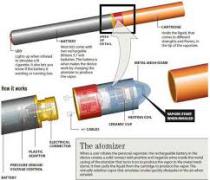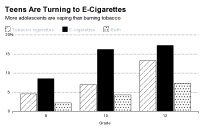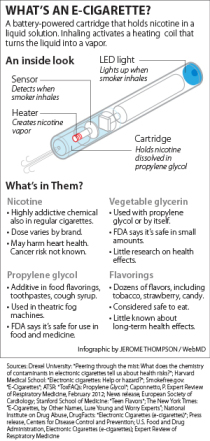E-cigarette use among middle and high school students skyrockets, CDC data show
The use of electronic cigarettes among middle and high school students has been rising rapidly, a trend that public health officials worry could undermine decades of efforts to reduce youth smoking and put a growing number of teenagers on a path toward conventional cigarettes.
According to data released Thursday by the Centers for Disease Control and Prevention, the percentage of middle and high school students in the United States who have used e-cigarettes more than doubled from 2011 to 2012.
“The increased use of e-cigarettes by teens is deeply troubling,” CDC Director Tom Frieden said in announcing findings from the National Youth Tobacco Survey. “Nicotine is a highly addictive drug. Many teens who start with e-cigarettes may be condemned to struggling with a lifelong addiction to nicotine and conventional cigarettes.”
E-cigarettes are battery-powered devices that look like cigarettes but do not burn tobacco. Rather, they deliver nicotine, flavor and other chemicals in the form of a vapor. A starter kit, which typically includes two e-cigarettes, extra batteries and various nicotine cartridges, can cost $20 to $200. Because of the limited research into e-cigarette use, their risks and benefits remain uncertain and subject to widespread debate.
What’s more certain is their steady growth in popularity among adults and, according to the CDC survey, young people. The survey found that the percentage of high school students who said they had used an e-cigarette jumped from 4.7 percent in 2011 to 10 percent in 2012. Nearly 3 percent of those students said they had used an e-cigarette in the past 30 days, up from 1.5 percent a year earlier. Use also doubled among middle school students, the CDC reported.
All told, more than 1.78 million middle and high school students nationwide had tried e-cigarettes in 2012, the agency said. Perhaps most troubling for public health advocates, the survey found that more than three-quarters of middle and high school students who had used e-cigarettes within the past month also had smoked conventional cigarettes during the same period. About 1 in 5 middle school students who reported using e-cigarettes said they had never tried conventional cigarettes.
The CDC’s findings are in line with a more recent survey conducted in Florida that found that more than 4 percent of middle-schoolers and 12 percent of high-schoolers had tried e-cigarettes — figures that have risen dramatically over the past two years.
Big U.S. tobacco companies have begun scooping up e-cigarette manufacturers with an eye toward a not-so-distant future, when, some analysts say, sales of e-cigarettes could eclipse those of conventional cigarettes. This year alone, tobacco giants such as Lorillard, Altria and Reynolds have begun wading into the e-cigarette market. E-cigarette use also has boomed in Europe in recent years.
Anti-smoking activists say that the rise in the popularity has happened in part because the devices are largely unregulated and cultivate an image as a cooler, less harmful alternative to regular cigarettes. Although the Food and Drug Administration has long said it intends to expand its regulatory authority over tobacco products to include e-cigarettes, the agency has not done so.
“FDA needs to act and act quickly to get a handle both on the product and its marketing,” said Matthew Myers, president of the Campaign for Tobacco Free Kids. Without that kind of oversight, he said, e-cigarette companies have remained free to sell their products online and spend huge sums mimicking the advertising practices that big tobacco companies once used.
“We have seen e-cigarettes marketed using exactly the same images in exactly the same places that the cigarette industry used decades ago,” he said. “Open a magazine, and you’ll see beautiful women and young celebrities marketing e-cigarettes. Go to NASCAR, and you’ll see cars sponsored by e-cigarettes.” Those efforts to “re-glamorize” smoking, Myers said, threaten to undo years of efforts and millions of dollars spent on campaigns to cut down on youth smoking in the United States and could create a new generation of smokers.
Proponents of e-cigarettes reject comparisons to traditional cigarettes, arguing that they contain nowhere near the amount of harmful substances that smokers inhale. They also have argued that rather than creating a slippery slope that could lead nonsmokers toward other tobacco products, e-cigarettes have the potential to help people wean themselves off conventional cigarettes.
Thomas Kiklas, president of the Tobacco Vapor Electronic Cigarette Association, said he doesn’t buy the argument that e-cigarettes are a “gateway” to traditional cigarettes for young people. “Kids have been smoking for hundreds of years,” he said. “So I don’t think any singular technology is going to push kids into cigarette use.” At the same time, he said, the association “absolutely” does not support sales or marketing aimed at minors and encourages its members to adhere to local, state and federal tobacco laws. He said the group supports mandatory online age verification on e-cigarette sales.
The FDA’s Center for Tobacco Products still plans to assert its authority over e-cigarettes, its director said Thursday, in part because, without regulation, the agency has little way to know how safe or unsafe they are, how much nicotine or other chemicals users are inhaling, and whether the devices can help people quit smoking traditional cigarettes or lead them to try other tobacco products.
“We don’t yet understand the long-term effects of these novel tobacco products,” Mitch Zeller, the FDA’s top tobacco official, said in a statement. “These findings reinforce why the FDA intends to expand its authority over all tobacco products and establish a comprehensive and appropriate regulatory framework to reduce disease and death from tobacco use.”
Sources; Centers for Disease Control and Prevention & Brady Dennis – Washington Post
Big U.S. tobacco companies have begun scooping up e-cigarette manufacturers with an eye toward a not-so-distant future, when, some analysts say, sales of e-cigarettes could eclipse those of conventional cigarettes. This year alone, tobacco giants such as Lorillard, Altria and Reynolds have begun wading into the e-cigarette market. E-cigarette use also has boomed in Europe in recent years.
Anti-smoking activists say that the rise in the popularity has happened in part because the devices are largely unregulated and cultivate an image as a cooler, less harmful alternative to regular cigarettes. Although the Food and Drug Administration has long said it intends to expand its regulatory authority over tobacco products to include e-cigarettes, the agency has not done so.
“FDA needs to act and act quickly to get a handle both on the product and its marketing,” said Matthew Myers, president of the Campaign for Tobacco Free Kids. Without that kind of oversight, he said, e-cigarette companies have remained free to sell their products online and spend huge sums mimicking the advertising practices that big tobacco companies once used.
“We have seen e-cigarettes marketed using exactly the same images in exactly the same places that the cigarette industry used decades ago,” he said. “Open a magazine, and you’ll see beautiful women and young celebrities marketing e-cigarettes. Go to NASCAR, and you’ll see cars sponsored by e-cigarettes.” Those efforts to “re-glamorize” smoking, Myers said, threaten to undo years of efforts and millions of dollars spent on campaigns to cut down on youth smoking in the United States and could create a new generation of smokers.
Proponents of e-cigarettes reject comparisons to traditional cigarettes, arguing that they contain nowhere near the amount of harmful substances that smokers inhale. They also have argued that rather than creating a slippery slope that could lead nonsmokers toward other tobacco products, e-cigarettes have the potential to help people wean themselves off conventional cigarettes.
Thomas Kiklas, president of the Tobacco Vapor Electronic Cigarette Association, said he doesn’t buy the argument that e-cigarettes are a “gateway” to traditional cigarettes for young people. “Kids have been smoking for hundreds of years,” he said. “So I don’t think any singular technology is going to push kids into cigarette use.” At the same time, he said, the association “absolutely” does not support sales or marketing aimed at minors and encourages its members to adhere to local, state and federal tobacco laws. He said the group supports mandatory online age verification on e-cigarette sales.
The FDA’s Center for Tobacco Products still plans to assert its authority over e-cigarettes, its director said Thursday, in part because, without regulation, the agency has little way to know how safe or unsafe they are, how much nicotine or other chemicals users are inhaling, and whether the devices can help people quit smoking traditional cigarettes or lead them to try other tobacco products.
“We don’t yet understand the long-term effects of these novel tobacco products,” Mitch Zeller, the FDA’s top tobacco official, said in a statement. “These findings reinforce why the FDA intends to expand its authority over all tobacco products and establish a comprehensive and appropriate regulatory framework to reduce disease and death from tobacco use.”
Sources; Centers for Disease Control and Prevention & Brady Dennis – Washington Post










